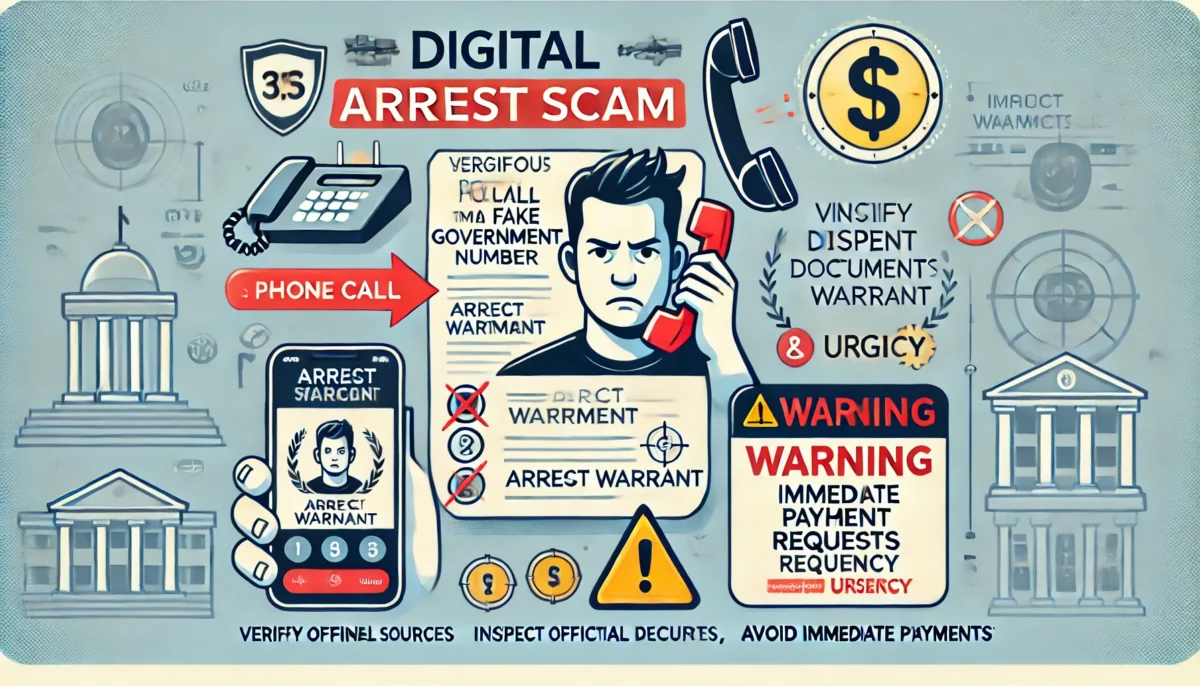The Digital Arrest Scam is a sophisticated scheme that preys on people’s fear of law enforcement and government authorities. Scammers impersonate officials from legal or tax departments to convince their targets that they’re facing severe legal consequences, which, they insist, can be avoided only by quickly following the scammers’ instructions. Below is a detailed look at how this scam operates, common scenarios, psychological tactics, and ways to protect yourself.
How the Digital Arrest Scam Operates
- Initial Contact
Typically, scammers begin by reaching out via phone calls, emails, or messaging apps like WhatsApp. To appear legitimate, they often spoof their phone numbers so the calls look like they’re coming from official government or law enforcement agencies. From the start, they assertively warn the target of supposed criminal activities tied to their identity, aiming to provoke anxiety and fear. - False Allegations
Next, scammers claim the target is under “digital arrest” or accused of a serious crime, with accusations that often include:- Money laundering or financial fraud
- Tax evasion or tax discrepancies
- Unpaid fines or loans
- Identity theft involving the target’s personal details
- Psychological Manipulation and Intimidation
Furthermore, to increase the target’s anxiety, scammers employ various fear tactics, such as:- Imminent Arrest Threats: They may claim police are en route to arrest the target unless immediate action is taken.
- Social Stigma: Additionally, scammers might threaten to publicize the case, damaging the target’s reputation.
- Asset Seizure Threats: They may also claim the target’s bank accounts or properties will be seized.
- Creating a Sense of Urgency
By telling the target to resolve the issue immediately or face arrest within hours, scammers limit the target’s time to think, verify the claims, or seek outside help. Thus, they create a sense of urgency, compelling the target to act quickly. - Payment and Personal Information Requests
Subsequently, they provide specific instructions to “clear” the target’s name, which typically involves:- Money Transfers: Scammers may instruct the target to wire money to a particular account.
- Gift Cards or Cryptocurrency: Often, they ask for payments in hard-to-trace forms like gift cards, cryptocurrency, or prepaid cards.
- Banking Information: Some ask for banking details, which they then use to drain accounts or commit identity theft.
- Personal Identification Details: Additionally, they sometimes request identification details for future scams.
- Fake Documentation
To further boost credibility, scammers may send false legal documents such as:- Fake arrest warrants
- Court notices with the target’s name
- Letters from tax or law enforcement agencies
Common Digital Arrest Scam Scenarios
- “Tax Fraud” Scenario
In this case, a “tax officer” calls and claims there’s an inconsistency in the target’s tax return, qualifying as fraud. They insist the target must pay a fine immediately to avoid arrest. - “Suspicious Bank Activity” Scenario
Alternatively, a scammer claims the target’s bank account is flagged for suspicious activities, supposedly linked to money laundering. They then instruct the target to transfer their funds to a “safe account” to prevent asset seizure. - “Unpaid Loan” Scenario
In yet another variation, the scammer says the target has an unpaid loan or debt, or claims someone used the target’s identity to take out a loan elsewhere, implicating them in fraud.
Why the Scam Works
The success of the digital arrest scam hinges on several psychological tactics:
- Fear and Stress: Most people have a natural fear of legal trouble, and the mere suggestion of criminal charges can lead to hasty, irrational decisions.
- Perceived Authority: By impersonating law enforcement or tax officials, scammers leverage the automatic trust and obedience people have toward authority figures.
- Limited Time to Respond: Furthermore, by creating a time crunch, scammers keep the target from consulting others or verifying the claims.
- Personal Details: Scammers often include details like names and addresses to add a sense of legitimacy.
Identifying and Avoiding Digital Arrest Scams
These steps can help you recognize and avoid becoming a victim:
- Verify Caller ID and Contact Information: If someone claims to represent a government or legal agency, verify their contact details independently. You can find most official numbers on government websites.
- Inspect Documents Closely: Fake documents usually show signs of haste, such as poor formatting, grammar errors, and unofficial email addresses. Genuine government communications will have verified contact methods and official seals.
- Contact Official Channels Directly: Use official websites to confirm the identity of any caller or sender. For instance, if someone claims to be from the tax department, call the tax office directly.
- Know Government Procedures: It’s essential to understand that legitimate agencies do not demand immediate payments over the phone, particularly in forms like gift cards, cryptocurrency, or prepaid cards.
- Protect Personal Information: Legitimate officials won’t ask for sensitive details like passwords, full banking information, or identification numbers over the phone or insecure messaging channels.
- Report the Incident: If you suspect you’re facing a scam, report it to the police or a cybercrime helpline. Many countries have dedicated agencies or online portals to report fraud.
What to Do if You’ve Been Targeted
If you realize you’ve fallen for a digital arrest scam, act quickly:
- Contact Your Bank: If you’ve sent money or shared banking information, alert your bank immediately to secure your accounts.
- Change Your Passwords: Update passwords for all sensitive accounts, especially if you provided personal details to the scammer.
- Report the Scam: Report the scam to local law enforcement to protect others from falling victim.
- Monitor Your Credit: Keep a close eye on your credit for any unauthorized transactions or new accounts in your name.
Helping Others Through Awareness
These scams rely heavily on instilling fear, and scammers continuously improve their tactics. Therefore, educating friends, family, and vulnerable individuals on how to identify scams and respond can be a powerful defense. Sharing these insights equips people to protect themselves and stay vigilant against future schemes.

